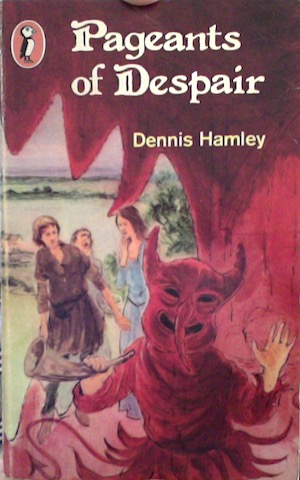Inspiring Young Readers
 posted on 28 Sep 2022
posted on 28 Sep 2022
John Gordon, Dennis Hamley, Penelope Lively: More children’s fiction from the 1960s & 70s
I have been further exploring children’s fiction from the 1960s and 70s with three more titles (previous reviews are here and here).
First was John Gordon’s first novel published in1968 called The Giant Under the Snow, which is set in East Anglia. It is just before Christmas. A trio of teenage school friends await the arrival of the Christmas holidays. Jonk (Jonquil) Winters, an independent (in fact rather contrary) young woman is bored by a tedious school field trip in the fen country ‘backlands’ and decides that rather than stick with the rest of her class she will strike out alone into the forest. Here she stumbles across a sprawling earthwork that seems to have human form. She finds an intricately chased golden belt buckle, hundreds, perhaps even thousands of years old. The all-enveloping fog becomes denser, the sinister woods even more frightening and a huge ghostly black dog attacks her. She is rescued by a strange, elegant, diminutive woman called Elizabeth Goodenough, a ‘guardian’ with an historic role to play in defending the world from attacks by dark forces.
To some degree, this seems to lean heavily on Susan Cooper’s The Dark is Rising sequence, but to my mind John Gordon is darker, the evil forces more frightening for being rooted in a contemporary 1970s setting rather than an ancient alternative underworld of magicians and sorcerers. The magic and fantasy elements are genuinely exciting – ‘Mr Gordon uses adrenaline for ink,’ Alan Garner said in a review of the book – but I also found that at times they became a slightly confusing jumble of too many competing ideas. This is a great shame because as I say the novel is superbly atmospheric and a glorious depiction of a genuinely dark and frightening pre-internet, pre-smartphone era that was buckling under the pressures of its own intense social change. I found the constant repetition of the (implausible) names of the main characters – Jonk, Arf and Bill – quickly became tedious.
I then read the largely forgotten Pageants of Despair (1974) by Dennis Hamley. Peter’s mother has been mugged and is in hospital. Initially, we don’t quite know how serious her injuries might be. Both Peter and his father are struggling to come to terms with the random violence inflicted on the family and the sense of violation this entails.
Peter’s father decides that he can cope better if Peter is looked after for a few weeks by his grandparents in the north of England. Travelling north on the train, alone for the first time – a journey which in better circumstances he would have relished – Peter speaks to a stranger, a man whose speech patterns and behaviour are archaic, his accent almost impenetrable. The man is a pageant-master from the fourteenth century who is searching for the handful of people who he feels can help him prevent a catastrophic over-turning of the events in the forthcoming cycle of mystery plays he is responsible for staging. Rather than being reassuringly familiar pageants of hope and comfort, the plays risk becoming pageants of despair with the potential to shape human consequences for millennia. Peter is transported back in time to help the stranger counter the forces that are seeking to subvert the centuries-old mystery plays.
This is an extraordinarily ambitious novel and the author’s grasp of medieval history, of the place in social and religious life occupied by the mystery plays are superb, as is the evocation of fourteenth century village life. But perhaps the weight of research is too much: I sometimes found the medieval sequences confusing and too drawn out, with too little happening to hold my attention. Nonetheless, this is a novel in which immense effort and skill have been invested and anyone with an interest in historical fiction will find a lot to enjoy in it.
The third novel I read was Penelope Lively’s The Wild Hunt of Hagworthy (1971). Lucy, twelve, is spending summer in the Somerset countryside with an aunt. She is struggling with the emotional and practical fall-out of her parents’ separation and the fact that her mother, now remarried, has a new baby boy that she, Lucy, hasn’t even seen. Her father, in an effort to clear some space for work as the school holidays start, packs Luck off to stay with his sister, Mable. He will follow once his own work holidays begin.
Again, what really makes this wonderfully atmospheric novel is the incidental writing – a perfect time capsule of late-60s rural life captured at a time of great social change. I have seen some reviewers describe it as ‘slow’, and I think it is, just a little, in the middle. Nonetheless, if you are looking for highly atmospheric writing rather than fast-paced shocks and excitement it can be highly recommended. Of the three this is the one I am most likely to read again. The John Gordon and the Dennis Hamley will make perfect December reading.
I wonder what younger readers today might make of these strange, unsettling and sometimes even experimental works of fiction from fifty years ago. I can imagine that discovering these and similar novels for the first time would be like finding hidden treasure from a remote past that is both magical and weirdly primitive.
Alun Severn
September 2022

